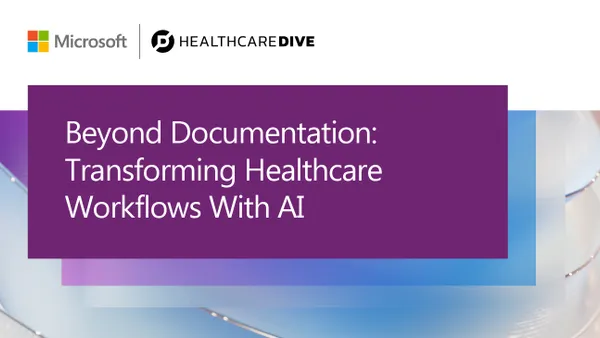Artificial Intelligence (AI) and Intelligent Automation (IA) have been drawing the attention of our readership and peppering the mindshare of organizations’ leaders. Across both clinical operations and administrative functions, AI has become central to how health systems pursue efficiency gains in the face of rising costs and rising patient expectations.
But what’s actually happening?
“Administrative efficiencies is where you can start”. Administrative functions have been one of the areas where many health systems have been testing their AI capabilities and building their knowledge. As of late last year, 40% of health systems had started to implement some form of generative AI, and another 40% were conducting proofs of concept, and “administrative efficiency” was the area with the greatest focus from those health systems.
Discussions with health systems highlight where organizations are starting to engage, learn from, and enhance their AI expertise. The AI mentions aren’t all big or complex, but they stand to have a sizeable impact. A few examples:
- Grant support –health systems are engaging with AI to help them with the management of grant and funding requests; from organizing dates, identifying the collection of content, to even writing the responses to grant requests for review. Health systems are finding immediate leverage in what is typically a tedious process.
- Denial and appeal management in revenue cycle – leveraging AI to cull and synthesize status, rationale, and actions related to revenue cycle exceptions has proven to drive efficiencies. Organizations report reducing time demands on teams without compromising the human experience and oversight in the process.
- Connecting insights from customer satisfaction and employee engagement data – AI engines are being pointed towards highly qualitative data to help synthesize and assimilate input quickly for their leaders to engage with and react to; leveraging AI for survey data, employee sentiment, and vendor feedback has identified insights quickly to facilitate faster response.
Our discussions on-the-ground have highlighted that while AI’s potential is real, and lofty, the practices and uses remain tactical and practical for the moment. This is not unexpected but may come as a surprise as one reads about all the potential for the technology’s future.
So, where to go? Some immediate, practical next steps
You are likely being asked (or tasked!) by your leaders to work with AI and show progress. Like many of your peers, you may be wondering just how far behind you may be. Our discussions with health systems have reinforced for us that the best way to start is simply to start. Allowing the process to be iterative increases the likelihood that your program will achieve enterprise goals and produce value.
Consider these six immediate steps to help you get moving (more on these can also be found here):
- Identify problems to solve that generate value and where success can be measured: Identify use cases that can create “needle-moving” results, but may not need to be 100% accurate from the AI itself (e.g., an employee answer can’t be wrong, but if routed to an HR employee for review may create some significant efficiency gains)
- Involve the right people to work on it and act as stakeholders early: Consider resources that have a passion for AI, are tech-savvy (e.g., skilled in prompt engineering), and aware of AI’s limitations
- Pick the right model, and work on it: The model’s capabilities should match the complexity and type of data it will need to handle; adjusting the parameters of the model can significantly enhance the model’s accuracy and efficiency
- Shape the reference/training data to support the model: Identify the necessary data, documents, and information to support the pilot program; pilot performance can vary widely based on how well the data is organized (e.g., does it need reformatting? How standardized is it? Are there file conversions required?)
- Iterate and invest to get the most out of it and see how far you can take it: Define and adopt an iterative process for your program, continuously refining the approach and documenting the lessons
- Monitor progress, back the winners, and prepare to move to production: A few use cases can make all the difference to help you move to production and showcase value
In the coming decade, AI will not be optional; it will instead redefine how health systems operate, compete, and deliver care. Leaders who adopt AI with discipline, ground it in strong data foundations, and design solutions around people and outcomes will gain a lasting edge. By focusing on results, building trust, and scaling thoughtfully, leaders can create systems that are more efficient, resilient, and patient-centered.
Sources:
- Launching a Successful AI Pilot Program: A Guide for Executives, ScottMadden, Inc.
- Artificial Intelligence and Your Technology Roadmap: Thoughts from a Conference, ScottMadden, Inc.
- Achieve Real Artificial Intelligence Results in Finance, ScottMadden, Inc.
- Healthcare turns to AI for medical note-taking ‘scribes’, Financial Times
- The Healthcare AI Adoption Index, Bain & Company
- Generative AI in Healthcare: Current Trends and Future Outlook, McKinsey & Company










